Quartermaster General of the United States Army
| Quartermaster General of the United States Army | |
|---|---|
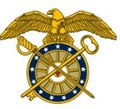 | |
since June 2, 2023 | |
| Formation | June 16, 1775 |
| First holder | MG Thomas Mifflin |
| Website | Official website |
The Quartermaster General of the United States Army is a general officer who is responsible for the Quartermaster Corps, the Quartermaster branch of the U.S. Army. The Quartermaster General does not command Quartermaster units, but is primarily focused on training, doctrine and professional development of Quartermaster soldiers. The Quartermaster General also serves as the Commanding General, U.S. Army Quartermaster Center and School, Fort Gregg-Adams, Virginia and the traditional Quartermaster Corps.
History
[edit]The office of the Quartermaster General was established by resolution of the Continental Congress on 16 June 1775, but the position was not filled until 14 August 1775. Perhaps the most famous Quartermaster General was Nathanael Greene, who was the third Quartermaster General, serving from March 1778 to August 1780. The first Quartermaster General to serve in the U.S. Army was Thomas Mifflin of Pennsylvania.
18th century
[edit]The position of Quartermaster General originated in the Continental Army, under order of Congress. On 16 June 1775, 2 days after the birth of the Army, Congress ordered the creation of both a Quartermaster General and a Deputy Quartermaster General. During this period Quartermasters General would be act like chiefs of staff for the commanders of the Continental Army, acting as the prime supplier and businessmen for dealing with civilians, operated and repaired supply lines, which included the roads which they traveled upon, was responsible for transporting troops and furnished all the supplies needed to establish camps when the troops got there.[1]
Upon the establishment of the position, Congress authorized George Washington to appoint the first Quartermaster General. He picked a man from amongst his aides-de-camp, Maj. Thomas Mifflin. Mifflin, an experienced merchant from Philadelphia, proved to be a prime choice, being reappointed several times to the position. They eventually promoted Mifflin to a colonel in order to retain him in his position.[2]
19th century
[edit]Fifteen officers held the office of quartermaster general in the United States Army in the nineteenth century. The first, John Wilkins Jr., was a major general. Two colonels, James Mullany and George Gibson, jointly held the office between April 29, 1816, and April 14, 1818. On May 8, 1818, Thomas Jessup became the Quartermaster General, and he remained in the position until 1860. As a combat veteran, Jessup understood the importance of support to front line soldiers and instituted many enduring practices and policies. Because of his reforms, historians often call Jessup the "father of the Quartermaster Corps". From 1860 to the end of the century, the quartermaster general office was held by officers who served in the American Civil War.
Brigadier General Joseph E. Johnston held the position from June 28, 1860, until his resignation on April 22, 1861. Johnston was appointed a full general in the Confederate States Army on August 31, 1861. Adhering to the ideology of states' rights, quartermasters of each Confederate state exercised considerable autonomy from their national quartermaster general. Within their jurisdictions, these Confederate officers exercised powers equivalent to the Union quartermaster general. Georgia quartermaster general Ira Roe Foster is, perhaps, the best example of a Confederate quartermaster exercising considerable power over both production and supply within his state. Brigadier General Montgomery C. Meigs succeeded Johnston on May 15, 1861. Meigs was born in Augusta, Georgia but his family was from Philadelphia and he adhered to the Union during the Civil War. Meigs served throughout the war and retired on February 6, 1882. Contemporaries such as U.S. Secretary of State William H. Seward and many historians have given Meigs's work in keeping the Union Army adequately and timely supplied considerable credit for the Union victory.
From February 13, 1882, to February 23, 1882 Daniel H. Rucker was quartermaster general, an appointment intended to honor his many years of military service. At the end of his brief tenure, Rucker retired. Rufus Ingalls, a brevet brigadier general and quartermaster for all Union Army forces during the Siege of Petersburg succeeded Rucker. Ingalls also had a brief tenure in office, serving between February 23, 1883, and July 1, 1883, when he also retired. Samuel B. Holabird, who was chief quartermaster of the Union Department of the Gulf during much of the Civil War, succeeded Ingalls and served from July 1, 1883, to June 16, 1890. Richard Napoleon Batchelder, quartermaster for II Corps of the Union Army and a recipient of the Medal of Honor, succeeded Holabird. He held the office between June 26, 1890, and July 27, 1896.
Another brevet brigadier general who had served as quartermaster for II Corps, Charles G. Sawtelle, succeeded Batchelder. He served between August 19, 1896, and February 16, 1897. George H. Weeks, who served as quartermaster with the III Corps of the Union Army, held the office between February 6, 1897, and his retirement on February 3, 1898.
The last quartermaster general of the 19th century was Marshall I. Ludington, who assumed the office on February 3, 1898, three months before the Spanish–American War. Ludington had served as a division quartermaster for the Army of the Potomac. He was criticized for the general unpreparedness of the U.S. Army for the Spanish–American War but he had inherited the general state of unpreparedness of the army, which had been given meager funds and kept small during the long period of relative peace that followed the Civil War. Ludington succeeded in improving the supply situation of the U.S. Army to an adequate state in a matter of months after the start of the war. He was promoted to major general on April 12, 1903, and retired the next day.
Duties at close of century
[edit]At the close of the 19th century, in an annual report for Congress, the Quartermaster General defined his duties as follows.[3]
Under existing laws the Quartermaster's Department, under the direction of the Secretary of War, provides the Army with military stores and supplies requisite for its use, such as clothing and equipage, tents, band instruments, tableware and mess furniture, equipments for post bakeries, fuel, forage, stationery, lumber, straw for bedding for men and animals, all materials for camp, and for shelter for troops and stores, furniture for barracks, such as bunks, benches, chairs, tables, lockers, heating and cooking stoves for use in public barracks and quar ters, tools for mechanics and laborers in the Quartermaster's Department, furniture. Text-books, papers, and equipment for post schools, reading matter for post libraries, wagons, ambulances, carts, saddles, harness, water supply, sewerage, plumbing, illuminating supplies, and heating for all military posts and buildings.
The Department is also charged with the duty of transporting, by land and water, troops, munitions of war, equipments, and all articles of military supplies from the place of purchase to the several armies, garrisons, posts, and recruiting places.
Under act of Congress amending section 1661, Revised Statutes, for arming and equipping the militia, this Department supplies quarter: master stores, clothing, and equipage to the militia of the several States and Territories, and transports the same to said States and Territories. It also furnishes transportation for ordnance and ordnance stores issued by the United States to the militia of the several States and Territo ries. It also transports the property for other Executive Departments on requisitions, payments therefor being made by the respective Depart ments to the carriers upon accounts forwarded through the Quarter master-general's Office for that purpose.
This Department prepares the necessary plans and constructs all buildings at military posts, such as barracks, quarters, storehouses, hospitals, etc., builds wharves, constructs and repairs roads for military purposes, builds all necessary military bridges, provides, by hire or pur chase, grounds for military encampments and buildings; contracts for all horses for cavalry, artillery, and for the Indian scouts, and for such infantry and members of the Hospital Corps in the field campaigns as may be required to be mounted; pays for all incidental expenses of the military service which are not provided by other corps.
20th century
[edit]
In 1907 James B. Aleshire was named Quartermaster General; he would retire in 1916 with the rank brigadier general. Aleshire was notable for combining the formerly separate Quartermaster, Subsistence and Pay Departments to create the consolidated U.S. Army Quartermaster Corps. He named his classmate and subordinate, Henry Granville Sharpe, the father of consolidation. Sharpe and Aleshire succeeded at eliminating the unwieldy centralized control of the army supply system that had grown up after the end of the American Civil War.[4] In addition to creating administrative departments at his headquarters to manage the day to day operations of the Quartermaster Corps, Aleshire replaced centralized purchasing with a decentralized system that saved time and money by enabling department, division, and unit quartermasters to procure supplies locally.[5]
World War I
[edit]Sharpe succeeded his friend and was named the 24th Quartermaster General on September 16, 1916; his term in office was to end on July 21, 1918. His appointment predated the entry of the United States to World War I by seven months. The Quartermaster Corps and the War Department generally were unprepared for World War I. The supply bureaus within the Quartermaster Corps were eager to procure and ship as quickly as possible the enormous quantities of supplies for which they were responsible. However, their uncoordinated procurement due to the Sharpe-Aleshire decentralization resulted in excessive and unbalanced railway shipments that overtaxed port facilities and finally developed into a serious congestion of the railroad system in the winter of 1917–18. By that time shortages in clothing, hospital equipment, and other supplies were causing hardships in Army camps, and it was charged by some that the lack of adequate clothing and shelter was responsible for an epidemic of pneumonia sweeping through the camps. General Sharpe was held responsible by many for a large share of the supply crisis that had developed.
These developments stirred a widespread uneasiness that led to a Congressional hearing on the conduct of the war. In the end the General Staff took complete control of supplies and the Office of the Director of Purchase and Storage in the Purchase, Storage, and Traffic Division was erected on the foundation of the Quartermaster Corps.
On December 15, 1917, a War Council was formed (as distinct from the Council of National Defense) consisting of the Chief of Staff of the United States Army Tasker H. Bliss, the Secretary of War Newton D. Baker, his Assistant and some subordinates amongst whom were Quartermaster General Henry Granville Sharpe and Chief of Ordnance William Crozier.[6] The War Council was to oversee and coordinate all matters of supply and to plan for the more effective use of the military power of the nation. While serving on the Council on 18 December 1917, General Sharpe was required to delegate all his administrative duties to an acting chief Quartermaster designated by the Secretary of War Newton D. Baker to be George Washington Goethals. Baker fired three of the five officers appointed to the War Council on that day.[7]
In June 1918, General Sharpe was relieved from duty with the War Council and assigned to the command of the Southeastern Department. The following month he was appointed a major general in the line of the Army, with rank from July 12 and officially ceased to be Quartermaster General.
World War II
[edit]In 1940 Edmund B. Gregory was appointed as the Army's Quartermaster General, advancing from colonel directly to major general. In 1945 he was promoted to lieutenant general, the first Quartermaster Officer to attain this rank. As Quartermaster General during World War II, he oversaw the development, procurement and distribution of billions of dollars worth of equipment and supplies. Gregory also supervised the training of thousands of quartermaster soldiers. In addition, he had responsibility for over 900,000 civilian personnel employed by contractors to produce supplies, equipment, ammunition and vehicles for the war effort.
Post-war years
[edit]On July 30, 1999, Major General Hawthorne L. Proctor was named the 46th Quartermaster General. He was the first African-American to hold the position.[8]
21st century
[edit]Twelve officers held the office of quartermaster general in the United States Army in the twenty-first century.
Major General Hawthorne L. Proctor: Major General Hawthorne L. Proctor served as the 46th Quartermaster General and Commandant of the Quartermaster School at Fort Lee, Virginia from 30 July 1999 to 11 July 2001. Brigadier General Proctor became the first African American Quartermaster Corps General.
Major General Terry E. Juskowiak: Major General Scott G. West served as the 47th Quartermaster General and Commandant of the Quartermaster School at Fort Lee, Virginia from 11 July 2001 to 16 May 2003.
Brigadier General Scott G. West: Brigadier General Scott G. West served as the 48th Quartermaster General and Commandant of the Quartermaster School at Fort Lee, Virginia from 16 May 2003 to 11 August 2005.
Brigadier General Mark A. Bellini: Brigadier General Mark A. Bellini served as the 49th Quartermaster General and Commandant of the Quartermaster School at Fort Lee, Virginia from 11 August 2005 to 26 October 2007.
Brigadier General Jesse R. Cross: Brigadier General Jesse R. Cross served as the 50th Quartermaster General and Commandant of the Quartermaster School at Fort Lee, Virginia from 26 October 2007 to 22 November 2010. Jesse Cross
Brigadier General Gwen Bingham: Brigadier General Gwen Bingham served as the 51st Quartermaster General and Commandant of the Quartermaster School at Fort Lee, Virginia from 22 November 2010 to 30 August 2012. Brigadier General Gwen Bingham became the first female to serve as Quartermaster General and the first female African American Quartermaster Corps General. She assumed command of the Quartermaster Corps from Brigadier General Jesse Cross on November 23, 2010. Bingham was promoted to brigadier general in April 2011. She was promoted to major general in 2013. In 2014 Bingham became the first female officer to serve as Commanding General of the U.S. Army Tank-Automotive and Armaments Life Cycle Management Command, in Warren, Michigan. In 2016, Bingham was promoted to lieutenant general, and became the 14th U.S. Army assistant chief of staff for installation management (ACSIM). Gwen Bingham
Brigadier General John E. O'Neil IV Brigadier General John E. O'Neil IV served as the 52nd Quartermaster General and Commandant of the Quartermaster School at Fort Lee, Virginia from 14 June 2013 to 9 June 2014. He currently serves as the Director for Logistics, Engineering and Security Cooperation (J4), U.S. Pacific Command, Camp H. M. Smith, Hawaii. John E. O'Neil IV
Brigadier General Ronald Kirklin Brigadier General Ronald Kirklin served as the 53rd Quartermaster General and Commandant of the Quartermaster School at Fort Lee, Virginia from 9 June 2014 to 10 June 2016. Ronald Kirklin
Brigadier General Rodney D. Fogg Brigadier General Rodney D. Fogg served as the 54th Quartermaster General and Commandant of the Quartermaster School at Fort Lee, Virginia from 10 June 2016 to 12 June 2018. Fogg served as the Commanding General of the Combined Arms Support Command and Sustainment Center of Excellence, CASCOM, Fort Lee, Virginia. Rodney D. Fogg
Brigadier General Douglas M. McBride: Brigadier General Douglas M. McBride, Jr. served as the 55th Quartermaster General and Commandant of the Quartermaster School at Fort Lee, Virginia from June 2018 to 29 May 2020. McBride was appointed as the interim commander of the US Army Combined Arms Command / Sustainment Center of Excellence on 23 August 2018. Douglas M. McBride Jr.
Brigadier General Michelle K. Donahue: Michelle K. Donahue became the Army's 56th Quartermaster General May 29, 2020 through June 22, 2022. Donahue pinned on the rank of brigadier general during a promotion ceremony June 24 at the Army Women's Museum.
Brigadier General Michael B. Siegl: Brigadier General Michael B. Siegl is the 57th and current United States Army Quartermaster General and Commandant of the United States Army Quartermaster School. Siegl is the first Asian American Quartermaster Corps Commandant and general.[9] Siegl was promoted to brigadier general in September 2022.[10]
List of Army Quartermasters General
[edit]| Name | Photo | Term began | Term ended | |
|---|---|---|---|---|
| 1. | MG Thomas Mifflin |  |
August 14, 1775 | May 16, 1776 |
| 2. | COL Stephen Moylan | 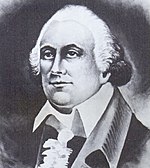 |
June 5, 1776 | September 27, 1776 |
| 1. | MG Thomas Mifflin |  |
October 1, 1776 | November 17, 1777 |
| 3. | MG Nathanael Greene |  |
March 2, 1778 | August 5, 1780 |
| 4. | COL Timothy Pickering |  |
August 5, 1780 | July 25, 1785 |
| 5. | Samuel Hodgdon |  |
March 4, 1791 | April 19, 1792 |
| 6. | James O'Hara |  |
April 19, 1792 | May 1, 1796 |
| 7. | MG John Wilkins, Jr. | 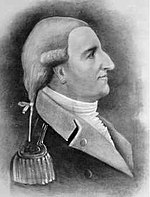 |
June 1, 1796 | June 1, 1802 |
| 8. | BG Morgan Lewis |  |
April 3, 1812 | March 2, 1813 |
| 9. | BG Robert Swartwout |  |
March 21, 1813 | June 5, 1816 |
| 10. | COL James Mullany | April 29, 1816 | April 14, 1818 | |
| 11. | COL George Gibson |  |
April 29, 1816 | April 14, 1818 |
| 12. | BG Thomas S. Jesup |  |
May 8, 1818 | June 10, 1860 |
| 13. | BG Joseph E. Johnston | 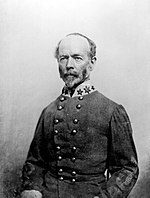 |
June 20, 1860 | April 22, 1861 |
| 14. | BG Montgomery C. Meigs |  |
May 15, 1861 | August 1, 1863 |
| Acting | COL Charles Thomas | August 1, 1863 | January 9, 1864 | |
| 14. | BG Montgomery C. Meigs |  |
January 9, 1864 | February 6, 1882 |
| 15. | BG Daniel H. Rucker |  |
February 13, 1882 | February 23, 1882 |
| 16. | BG Rufus Ingalls |  |
February 23, 1882 | July 1, 1883 |
| 17. | BG Samuel B. Holabird |  |
July 1, 1883 | June 16, 1890 |
| 18. | BG Richard Batchelder |  |
June 26, 1890 | July 27, 1896 |
| 19. | BG Charles G. Sawtelle |  |
August 19, 1896 | February 16, 1897 |
| 20. | BG George H. Weeks |  |
February 16, 1897 | February 3, 1898 |
| 21. | BG Marshall I. Ludington |  |
February 3, 1898 | April 12, 1903 |
| 22. | BG Charles F. Humphrey |  |
April 12, 1903 | July 1, 1907 |
| 23. | MG James B. Aleshire |  |
July 1, 1907 | September 12, 1916 |
| 24. | MG Henry G. Sharpe |  |
September 16, 1916 | July 21, 1918 |
| 25. | MG Harry Lovejoy Rogers |  |
July 22, 1918 | August 27, 1922 |
| 26. | MG William H. Hart |  |
August 28, 1922 | January 2, 1926 |
| 27. | MG B. Frank Cheatham |  |
January 3, 1926 | January 17, 1930 |
| 28. | MG John L. DeWitt |  |
February 3, 1930 | February 3, 1934 |
| 29. | MG Louis H. Bash |  |
February 3, 1934 | March 31, 1936 |
| 30. | MG Henry Gibbins |  |
April 1, 1936 | March 31, 1940 |
| 31. | LTG Edmund B. Gregory |  |
April 1, 1940 | January 31, 1946 |
| 32. | MG Thomas B. Larkin |  |
February 1, 1946 | March 21, 1949 |
| 33. | MG Herman Feldman |  |
March 21, 1949 | September 28, 1951 |
| 34. | MG George A. Horkan |  |
September 29, 1951 | January 1954 |
| 35. | MG Kester L. Hastings |  |
February 1954 | March 1957 |
| 36. | MG Andrew T. McNamara |  |
June 1957 | June 11, 1961 |
| 37. | MG Webster Anderson |  |
June 12, 1961 | July 31, 1962 |
| 38. | MG Harry L. Dukes, Jr. |  |
July 15, 1981 | March 29, 1984 |
| 39. | MG Eugene L. Stillions, Jr. |  |
March 29, 1984 | June 4, 1987 |
| 40. | MG William T. McLean |  |
June 15, 1987 | July 14, 1989 |
| 41. | MG Paul J. Vanderploog |  |
July 14, 1989 | June 3, 1991 |
| 42. | BG John J. Cusick |  |
July 24, 1991 | August 3, 1993 |
| 43. | MG Robert K. Guest |  |
August 3, 1993 | June 21, 1996 |
| 44. | MG Henry T. Glisson | 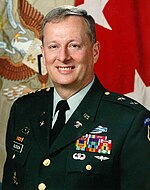 |
June 21, 1996 | June 10, 1997 |
| 45. | MG James M. Wright |  |
June 10, 1997 | July 30, 1999 |
| 46. | MG Hawthorne L. Proctor |  |
July 30, 1999 | July 11, 2001 |
| 47. | MG Terry E. Juskowiak |  |
July 11, 2001 | May 16, 2003 |
| 48. | BG Scott G. West |  |
May 16, 2003 | August 11, 2005 |
| 49. | BG Mark A. Bellini |  |
August 11, 2005 | October 26, 2007 |
| 50. | BG Jesse R. Cross |  |
October 26, 2007 | November 22, 2010[11] |
| 51. | BG Gwen Bingham |  |
November 22, 2010 | August 30, 2012 |
| 52. | BG John E. O'Neil IV |  |
June 14, 2013 | June 9, 2014 |
| 53. | BG Ronald Kirklin |  |
June 9, 2014 | June 10, 2016 |
| 54. | BG Rodney D. Fogg |  |
June 10, 2016 | June 12, 2018 |
| 55. | BG Douglas M. McBride Jr. |  |
June 12, 2018 | May 29, 2020[12] |
| 56. | BG Michelle K. Donahue |  |
May 29, 2020 | June 22, 2022 |
| 57. | BG Michael B. Siegl |  |
June 22, 2022[13] | June 2, 2023 |
| 58. | COL Jin H. Pak |  |
June 2, 2023[14] | Present |
See also
[edit]- Military supply
- Quartermaster
- Quartermaster Center and School
- Quartermaster Corps (United States Army)
- Quartermaster general
- All pages with titles beginning with Quartermaster
References
[edit]- ^ Risch 30
- ^ Risch 30-31
- ^ "Annual Report of the Quartermaster-General of the Army, to the Secretary of War, for the Fiscal Year Ended June 30, 1897".
 This article incorporates public domain material from websites or documents of the United States Army.
This article incorporates public domain material from websites or documents of the United States Army.
- ^ "Major General James B. Aleshire, 23rd Quartermaster School Commandant, July 1907 – September 1916". Previous Quartermaster Commandants. Fort Lee, VA: U.S. Army Quartermaster Corps. November 30, 2020. Retrieved August 4, 2022.
- ^ "23rd Quartermaster School Commandant".
- ^ F (1918). "War Department Organization". The American Political Science Review. 12 (4 (Nov., 1918), pp. 699-705): 699–705. doi:10.2307/1945843. JSTOR 1945843. S2CID 251093531.
- ^ "GOETHALS TO HEAD ARMY SUPPLIES; Succeeds Sharpe as Quartermaster in Shift Creating New War Council. WHEELER ORDNANCE CHIEF Will Act in Crozier's Place--Senate Holds up Latter's Confirmation. Order for War Council. GOETHALS TO HEAD ARMY SUPPLIES Quarrel over Navy Supplies". The New York Times. 19 December 1917.
- ^ "Notable Alumni: Hawthorne 'Peet' Proctor '77". Notable Alumni. Alumni Association. Central Michigan University, no date, accessed 2013-06-16; "Maj. Gen. (Ret.) Hawthorne L. 'Peet' Proctor Joins Turn Key Office Solutions". Press release. Turn Key Office Solutions. March 6, 2006.
- ^ Quartermaster General Bio / QMS Official Webpage
- ^ Nominations Confirmed, US Senate
- ^ "Quartermaster Generals". Archived from the original on 2008-08-23. Retrieved 2008-10-06. List of Quartermaster Generals of the United States Army
- ^ Bell, Terrance (June 2, 2020). "Col. Michelle Donahue becomes 56th Quartermaster General". U.S. Army. Retrieved 2020-11-22.
- ^ Menegay, Chad (June 24, 2022). "Sustainment Center of Excellence welcomes new Quartermaster General". DVIDS. Retrieved June 25, 2022.
- ^ Menegay, Chad (2023-06-02). "Col. Jin H. Pak becomes the 58th Quartermaster General". DVIDS. Retrieved 2023-06-03.
Sources
[edit]- Risch, Erna (1981). Supplying Washington's Army. Washington, D.C.: United States Army Center of Military History.

